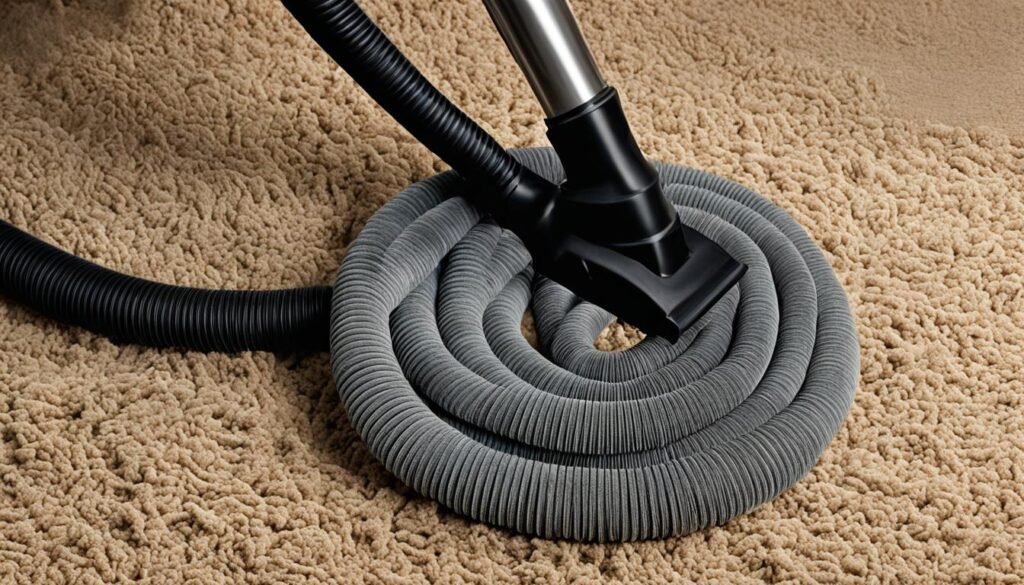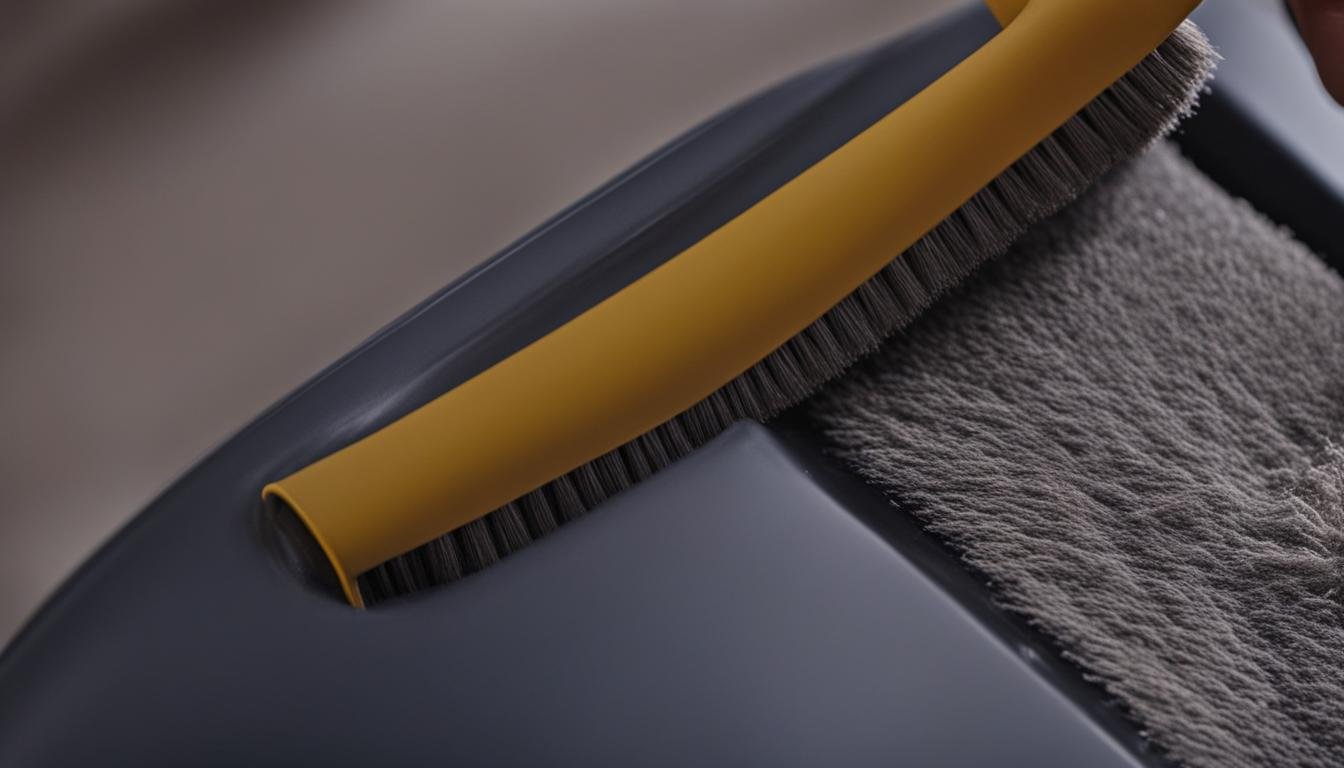Cleaning the vacuum cleaner hose is an essential maintenance task that can improve the performance and prolong the lifespan of your vacuum. It is recommended to clean the vacuum hose about once a month, although the frequency may vary depending on how often you use your vacuum. Signs that the hose is clogged include a loss of suction, difficulty picking up dirt and debris, and a bad smell coming from the vacuum.
Cleaning the hose involves detaching it from the vacuum, unclogging and removing clumps of dirt, washing it with soapy water or a mixture of baking soda and vinegar, using a bottle cleaning brush for stubborn grime, rinsing it thoroughly, and allowing it to dry completely before reattaching it to the vacuum. Regularly cleaning the vacuum hose can prevent blockages and ensure efficient cleaning performance.
Key Takeaways:
- Cleaning the vacuum cleaner hose once a month can improve performance and prolong the lifespan of your vacuum.
- Signs of a clogged hose include loss of suction, difficulty picking up dirt and debris, and a bad smell.
- Detach the hose, remove clumps of dirt, wash with soapy water or a baking soda and vinegar mixture, use a bottle cleaning brush for stubborn grime, rinse thoroughly, and allow to dry completely.
- Regularly cleaning the vacuum hose prevents blockages and ensures efficient cleaning performance.
- Proper maintenance of the vacuum cleaner hose leads to a cleaner and healthier living environment.
Tips for Maintaining a Vacuum Cleaner Hose
In addition to regular cleaning, there are a few tips you can follow to maintain your vacuum cleaner hose and ensure its optimal performance and longevity.
- Avoid using excessive force when detaching the hose from the vacuum. This will help prevent any potential damage to the hose and ensure it remains intact.
- When removing clumps of dirt, be careful not to apply too much pressure that could potentially cause a hole in the hose. Gentle handling is key.
- If your vacuum hose is particularly dirty, consider using a bottle cleaning brush with thin and long bristles. This will effectively scrub away stubborn grime and ensure a deeper clean.
- After cleaning, make sure to rinse the hose thoroughly to remove any loose dirt or grime that may have accumulated during the cleaning process.
- Allow the hose to dry completely before reattaching it to the vacuum. This will prevent any potential mold or mildew growth and maintain the hose’s cleanliness.
By following these tips, you can maintain your vacuum cleaner hose in good condition and ensure that it continues to perform optimally, providing you with efficient cleaning results.
Unclogging a Vacuum Cleaner Hose

Clogged vacuum hoses can be a frustrating issue, impacting the performance and efficiency of your vacuum cleaner. The good news is, with a few simple cleaning tips and hacks, you can unclog your vacuum hose and restore its suction power.
Firstly, detach the hose from the vacuum cleaner to access the clog. Use a yardstick, broomstick, or even a garden hose to gently dislodge the clump of debris. It’s important to work slowly and carefully to avoid damaging the hose.
If dislodging the clog manually doesn’t work, try running hot water through the hose to rinse out any loose dirt. The heat can help break down the clog and flush it out. Remember to hold the hose securely to prevent any splashing or mess.
For non-electrical vacuum cleaner hoses, a mixture of baking soda and white vinegar can be an effective solution. Simply pour the mixture into the hose and let it sit for a few minutes. The combination of baking soda and vinegar will work to dissolve stubborn clogs. Afterward, thoroughly rinse the hose with water to remove any remaining debris.
Important note:
Always hang the vacuum hose up to dry completely before reattaching it to the vacuum cleaner. This will prevent any mold or mildew from developing and ensure optimal performance.
Unclogging your vacuum cleaner hose doesn’t have to be a daunting task. By following these simple cleaning hacks and maintenance tips, you can prolong the life of your vacuum cleaner and keep it running smoothly.
Key Takeaways:
- Detach the hose and use a yardstick or broomstick to dislodge the clog.
- Try rinsing the hose with hot water to loosen and flush out debris.
- For non-electrical hoses, use a mixture of baking soda and white vinegar to dissolve stubborn clogs.
- Always allow the hose to dry completely before reattaching it to the vacuum cleaner.
Conclusion
Proper maintenance is key to ensuring the optimal performance and longevity of your vacuum cleaner hose. By regularly cleaning and inspecting your hose, you can prevent clogs, improve suction power, and maintain efficient vacuuming. Remember to detach the hose from the vacuum and use appropriate cleaning methods, such as washing with soapy water or a mixture of baking soda and vinegar. Allow the hose to dry completely before reattaching it to the vacuum to avoid any moisture-related issues.
Maintaining a clean vacuum hose not only enhances cleaning efficiency but also prevents unpleasant odors from developing. A well-maintained hose can effectively pick up dirt and debris, keeping your living environment cleaner and healthier. Additionally, proper maintenance can extend the lifespan of your vacuum cleaner, saving you money in the long run. Make vacuum cleaner hose maintenance a regular part of your cleaning routine to maximize performance and enjoy a cleaner home.
In addition to cleaning, it is essential to be mindful when using and storing your vacuum cleaner hose. Avoid applying excessive force when detaching the hose to prevent damage. Take care when removing clumps of dirt, ensuring not to exert too much pressure that could result in a hole. Following these tips, along with proper cleaning and maintenance, will help keep your vacuum cleaner hose in excellent condition for years to come.
FAQ
How often should I clean my vacuum cleaner hose?
It is recommended to clean the vacuum hose about once a month, although the frequency may vary depending on how often you use your vacuum.
How do I know if my vacuum cleaner hose is clogged?
Signs that the hose is clogged include a loss of suction, difficulty picking up dirt and debris, and a bad smell coming from the vacuum.
How do I clean a vacuum cleaner hose?
To clean the hose, detach it from the vacuum and unclog any clumps of dirt. Wash the hose with soapy water or a mixture of baking soda and vinegar. For stubborn grime, use a bottle cleaning brush. Rinse the hose thoroughly and allow it to dry completely before reattaching it to the vacuum.
What are some tips for maintaining a vacuum cleaner hose?
Avoid using excessive force when detaching the hose. Be careful not to apply too much pressure when removing clumps of dirt. Consider using a bottle cleaning brush for stubborn grime. Rinse the hose thoroughly and allow it to dry completely before reattaching it to the vacuum.
How can I unclog a vacuum cleaner hose?
To unclog a vacuum cleaner hose, you can try using a yardstick, broomstick, or garden hose to dislodge the debris. Running hot water through the hose or using a mixture of baking soda and white vinegar can also help break down stubborn clogs. Hang the hose up to dry completely before reattaching it to the vacuum.





Leave a Reply